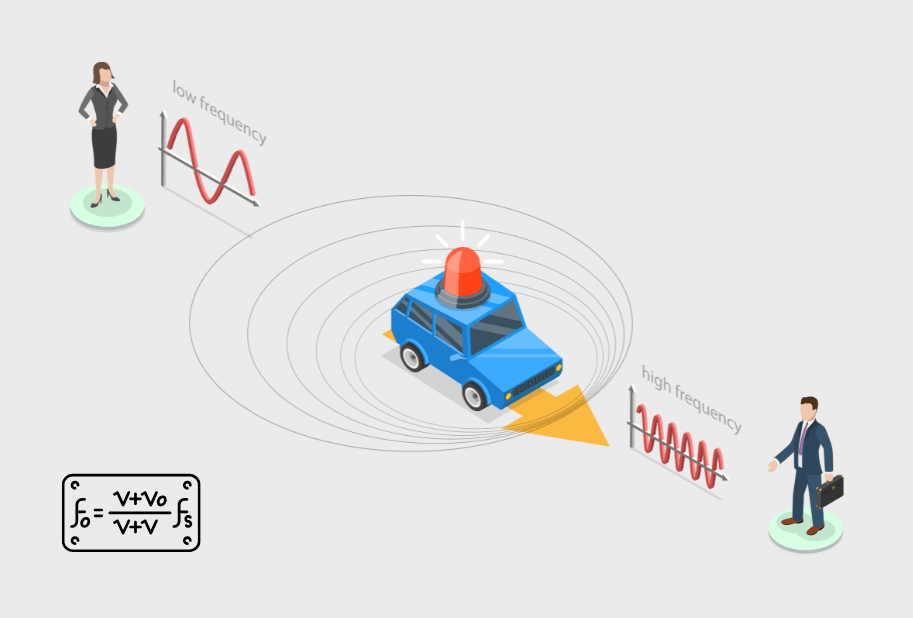The Doppler Effect is a physical phenomenon that describes the change in the frequency of a wave when the source of the wave and the observer are moving relative to each other. It can be observed not only in sound waves but also in electromagnetic waves. This effect occurs in many everyday situations, from moving vehicles to radio waves, making it one of the most common motion-related phenomena.
The Phenomenon of the Doppler Effect
To better understand the Doppler Effect, imagine a car moving along a road and emitting a sound at a constant frequency. When the vehicle approaches us, the sound becomes higher, and when it moves away, its frequency decreases, making the sound lower. This phenomenon occurs because, as the source of the wave approaches the observer, the sound waves are compressed, increasing the frequency. Conversely, when the source moves away, the waves are stretched, reducing their frequency.
It is applied not only in science but also in practical fields. It is used in police radars to measure vehicle speed, in medicine for Doppler ultrasonography to examine blood flow, and in astronomy to assess the motion of stars and galaxies.
Mathematical Explanation of the Doppler Effect
In the mathematical description of the Doppler Effect, formulas are used to determine how the frequency of a wave changes depending on the speed of the source and the observer. The formula for the Doppler Effect for sound waves is as follows:
f' = f \cdot \frac{v + v_o}{v + v_s}Where:
- f' – observed frequency,
- f – source frequency,
- v – wave propagation speed in the medium (e.g., air),
- v_o – observer’s speed,
- v_s – source speed.
When the source and observer move relative to each other, this formula can be used to precisely calculate frequency changes.
Examples of the Doppler Effect in Everyday Life
It can be observed in many everyday situations. One classic example is a passing train. When the train approaches the platform, we hear a higher pitch of the horn, and as it moves away, the sound becomes lower. This phenomenon results from the compression of sound waves during approach and their stretching during departure.
Another example is the use of radar by police to measure vehicle speed. The radar emits an electromagnetic wave that reflects off a moving vehicle. The changed frequency of the reflected wave allows the speed of the vehicle to be calculated using the Doppler Effect.
Applications of the Doppler Effect in Medicine
Doppler ultrasonography is one of the diagnostic tools in medicine that uses the Doppler Effect to measure the speed of blood flow in vessels. The ultrasound device emits sound waves that reflect off red blood cells moving inside blood vessels. Based on the frequency change of these waves, doctors can assess whether the blood flow is normal or if there are abnormalities, such as artery narrowing.
In medicine, it also enables the assessment of fetal heart activity during pregnancy, providing a safe and non-invasive way to monitor the baby’s health.
Astronomical Applications of the Doppler Effect
In astronomy, the Doppler Effect plays a crucial role in assessing the motion of stars and galaxies. When a celestial object moves away from Earth, the observed wavelength of light increases, shifting towards the red part of the spectrum (known as redshift). Conversely, when an object approaches us, the light wave shifts towards the blue part of the spectrum.
Redshift and blueshift are important tools for studying galaxy motion and confirming the theory of the expanding universe. Thanks to the Doppler Effect, scientists can also determine how fast cosmic objects are moving away from Earth, which is critical for cosmological research.
Applications of the Doppler Effect in Navigation and Communication
It is also used in navigation systems, such as GPS. Signals sent by satellites to the GPS receiver are modified by the Doppler Effect, allowing for precise determination of the object’s speed and location. Without this effect, accurately determining the position and speed of moving vehicles or people would be much more difficult.
In radio communication, the Doppler Effect affects the received frequencies of signals, which is particularly important in communication with objects moving at high speeds, such as satellites.
Practical Exercises to Understand the Doppler Effect
To better understand how the Doppler Effect works, try performing a few simple tasks:
- Observation of a passing car: Stand by the roadside and listen to the sound of passing cars. Notice how the sound changes when the car approaches and moves away.
- Experiment with a pendulum: Use a toy pendulum that emits sound and move it back and forth. Observe how the sound changes as the pendulum approaches and moves away from you.
FAQ – Frequently Asked Questions – Doppler Effect
It is the phenomenon of frequency change when the source and observer move relative to each other. An example is the change in pitch of a passing car’s sound.
It is used in radars, medicine (Doppler ultrasonography), and astronomy to study the motion of cosmic objects.
The sound of a passing train changes due to the Doppler Effect – the frequency increases as the train approaches and decreases as it moves away.
No, it also applies to electromagnetic waves, such as light and radio waves.




